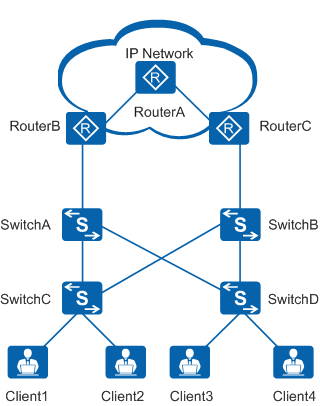NQA for Static Routes
As mentioned previously, static routes do not have a dedicated fault detection mechanism. If a fault occurs on a non-directly connected link, the corresponding static route will not be automatically deleted from the IP routing table. This can interrupt services for a significant amount of time. The network administrator must delete the corresponding static route to allow traffic to switch to an available path.
This problem requires an effective solution to detect faults in links for static routes. BFD for static routes is applicable only in situations where both communicating devices support it. However, if either of the two communicating devices supports Network Quality Analysis (NQA), NQA for static routes can be used to detect faults.
- If NQA detects a fault in the link, the system sets the static route to inactive. The route becomes unavailable and is deleted from the IP routing table.
- If NQA detects that the link has recovered, the system sets the static route to active. The route becomes available and is re-added to the IP routing table.
For details about NQA, see NQA Configuration in the S2720, S5700, and S6700 V200R019C10 Configuration Guide - Network Management and Monitoring.

When a static route is associated with an NQA test instance, only ICMP test instances are used to test whether the source and destination can be reached through routes.
Each static route can be associated with only one NQA test instance.
Applications
On the network shown in Figure 1, access switches connect to users. Because dynamic routing protocols are not available for communication between RouterB and users, static routes are configured on RouterB. To make the network more stable, RouterC is configured with static routes to the same destination as RouterB, providing route backup. RouterA, RouterB, and RouterC run a dynamic routing protocol to learn routes from each other. RouterB and RouterC import static routes using a dynamic routing protocol and have different costs configured for these static routes. After configuration is complete, RouterA can use the dynamic routing protocol to learn from RouterB and RouterC the routes to users. RouterA uses the link associated with the static route with the lower cost as the active link, and the other link as the standby link.
NQA for static routes is also configured on RouterB. NQA tests are performed to check the active link of RouterB → SwitchA → SwitchC → SwitchD. If the active link fails, the static route is deleted from the routing table, and traffic diverts to the standby link of RouterC → SwitchB → SwitchC → SwitchD. If both links are working properly, traffic travels along the active link.
